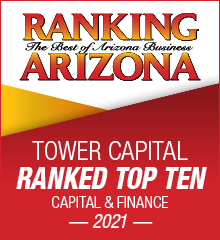The Rise and Fall (and rise again) of Interest Rates
Shifting interest rates are the never-ending, hot-button topic in the world of investing, and rightfully so. Changing rates not only affect our portfolios, but the entire U.S. economy. In commercial real estate, learning more about the factors that influence interest rates can both ease anxieties and lead to becoming a savvy investor.
The Basics
The interest rate that borrowers will pay on a loan is determined by a simple formula: Index Rate + Spread = Loan Interest Rate. The spread is a number calculated by the perceived risk of the loan or supply and demand in the market.
In the U.S., commercial real estate lending is predominately influenced by four indices: Federal Funds Rate, LIBOR, Prime, and US Treasury rates.
Federal Funds Rate
Although the Federal Funds Rate is not directly used to price commercial real estate loans, it is the primary tool our central bank, the Federal Reserve, uses to influence interest rates, control inflation, and manage the overall economy. Specifically, it is the rate that other banks charge each other for overnight borrowing.
Federal banking regulations dictate that banks must keep in reserve a certain percentage of their deposits to cover customers’ withdrawals. If the bank does not have these funds on hand at the end of the day, they must borrow the money from other banks. Although the two banks involved are free to negotiate the exact interest rate charged, it typically reflects the federal funds rate.
Changes in the Federal Funds Rate can heat up or cool down the economy by increasing or decreasing the cost of capital that trickles down to borrowers. The availability of less expensive capital boosts investment and adds liquidity to the financial market, spurring growth. Higher rates will have the opposite effect as investors choose to save instead of seeking new opportunities.
Prime Rate
The Prime rate is the rate that banks in the US charge their most creditworthy customers, typically large corporations, who offer the least amount of risk of default. It is a key lending rate on which banks base most of their variable interest, including personal and small business loans, credit cards, and interest-only mortgages. Commercial real estate construction loans financed through banks are typically interest-only and based upon a spread over the Prime rate.
The Prime rate generally moves in accordance with the federal funds rate and has historically been 300 basis points (or 3%) above the federal funds rate. The most widely used Prime rate is published daily in the Wall Street Journal and is an average of the largest banks’ prime rates.
LIBOR
Short-term commercial real estate bridge loans and floating rate loans are often priced over the 30-day LIBOR index.
The London Interbank Offer Rate, most commonly referred to as LIBOR, is the index preferred by international and large banks who have a concentration of foreign customers. These major global banks estimate what it would cost to lend to one another for short-term loans, and LIBOR is the average of those estimates.
LIBOR rates are offered with seven different maturities, but the 30-day is the most common in commercial real estate. The loans based on this index change monthly.
In 2017, the U.K.’s top regulator tasked with overseeing LIBOR announced that the benchmark will be phased out by the end of 2021. In the US, the Federal Reserve is recommending the Secured Overnight Financing Rate (SOFR) as a replacement, which has been published since April 2019.
US Treasury Rates
Treasury bills, notes, and bonds are debt instruments sold by the US government to raise money. Each treasury is sold at auction with a fixed face value and interest rate. They offer investors different lengths of maturities and rates of return. Treasury bills mature within one year, Treasury notes mature in 10 years or less, and Treasury bonds have maturities up to 30 years. Under normal conditions, longer-term Treasury securities have a higher yield than shorter-term Treasury securities.
When the economy trends negatively, Treasury yields typically decrease due to higher demand. This is because Treasuries are considered to offer the lowest risk to investors because they are backed by the full faith and credit of the US government. Conversely, when the economy positively, Treasuries become cheaper and their yields rise because there is less demand from investors who are willing to take greater risk for a higher return on their money through alternative investments. These can include higher yielding corporate bonds, equities in the stock market, mortgage backed securities, real estate or a variety of other investment vehicles.
Long-term fixed-rate loans, such as CMBS, Fannie Mae, Freddie Mac, HUD and many life insurance company loans, are priced over US Treasuries, the 10-year being the most common.
Summary
It is important for investors to have a basic understanding of interest rates, especially if they are financing commercial real estate properties. The US Prime rate, Treasury rates, and 30-day LIBOR, are the most common indexes used to price commercial real estate loans, while the Federal Funds rate is the benchmark from which many other rates are based. The index used to calculate the final rate paid by the borrower is dependent on multiple factors including the category of lender, property type, status of the asset and time horizon for the loan. Although many of the rates discussed are highly correlated, they do not always move together.
About Tower Capital:
Tower Capital was founded to enable owners of commercial real estate to achieve their investment goals with the least amount of time, energy, and cost, while creating surety of execution and peace of mind.
Established in 2015 and headquartered in Phoenix, Arizona, Tower Capital provides customized structured financing to investors throughout the United States. We specialize in debt and equity placement ranging from $2 Million to $100 Million and have financed over $1 billion for our clients since inception. We focus on independent financial advising with an entrepreneurial mindset, market vigilance and personalized attention to every client.





 Business News
Business News